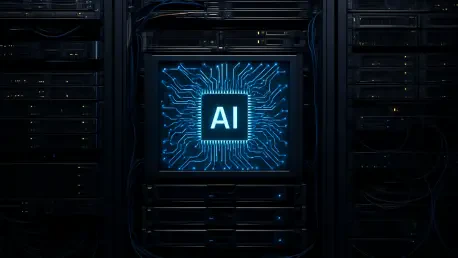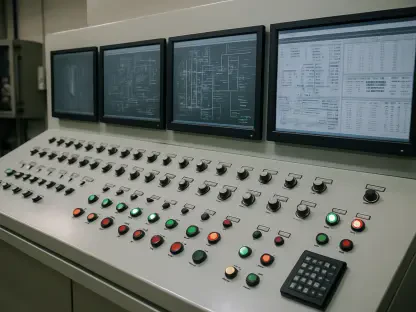In an era where artificial intelligence and cloud computing are reshaping the global technology landscape, Foxconn, a Taiwanese manufacturing titan historically tied to consumer electronics, is emerging as a surprising yet formidable leader. Known for assembling products for major brands like Apple, the company is now pivoting with remarkable agility toward the heart of the AI infrastructure boom. This transformation isn’t just about adapting to trends; it’s a calculated reinvention driven by soaring demand for data centers and networking solutions that power everything from generative AI to machine learning. By realigning its revenue streams, investing in cutting-edge innovation, and forging strategic alliances, Foxconn is positioning itself as a cornerstone of the digital transformation era. This shift raises intriguing questions about how a traditional contract manufacturer can redefine itself in a highly competitive, tech-driven market, setting the stage for a deeper exploration of its strategies and challenges.
Financial Powerhouse: The AI Server Boom
Foxconn’s financial trajectory in the current quarter reveals a staggering shift that underscores its new direction in the tech industry. With AI server revenue projected to surge by an impressive 170% year-over-year, the company is witnessing a structural change in its business model. Cloud and networking products are expected to constitute over 65% of its cloud equipment revenue, marking a significant departure from its historical focus. This isn’t merely a fleeting uptick; it reflects a fundamental realignment toward high-margin sectors that are critical to the future of technology. Already, AI server earnings have eclipsed traditional business lines in recent quarters, highlighting how swiftly Foxconn has adapted to capitalize on the explosive growth in data center infrastructure needed for advanced computational tasks. This financial pivot not only showcases the company’s responsiveness to market demands but also sets a precedent for others in the manufacturing space looking to transition into tech leadership roles.
Beyond the headline numbers, this financial surge points to a broader trend of recalibrating priorities in response to global needs. The emphasis on AI servers aligns with the escalating requirements of hyperscalers and cloud computing firms that underpin modern digital ecosystems. Foxconn’s ability to scale production and meet these demands demonstrates a keen understanding of where the industry is headed. Moreover, this growth isn’t just about revenue; it’s about establishing a foothold in a sector with long-term profitability potential. By focusing on infrastructure that supports AI and machine learning, Foxconn is not only diversifying its portfolio but also insulating itself against the volatility of consumer electronics markets. This strategic foresight positions the company as a key player in a domain where technological advancements are relentless, ensuring that its financial gains are tied to sustainable, forward-looking investments rather than short-term wins.
Strategic Expansion: Tapping into U.S. Markets
Foxconn’s strategic initiatives are as ambitious as its financial goals, particularly with its focus on expanding operations in the U.S. to meet the rising demand for AI infrastructure. A standout move is the repurposing of its Ohio facility to manufacture cloud and networking products, a clear signal of intent to localize production. Alongside this, the $735 million Project ETA initiative for data center modules and server assembly underscores a commitment to aligning with domestic market needs. These efforts are not just about increasing output; they are a deliberate strategy to mitigate risks associated with global supply chain disruptions. By establishing a stronger presence in the U.S., Foxconn is better equipped to serve American clients while navigating geopolitical uncertainties that often impact international logistics.
This expansion also reflects a nuanced understanding of market dynamics and the importance of proximity to key customers. Localized production reduces lead times and costs associated with shipping, while also fostering trust with U.S.-based hyperscalers and tech giants driving AI adoption. Furthermore, these initiatives help Foxconn comply with regional regulations and preferences for domestically manufactured tech solutions, enhancing its competitive edge. The focus on the U.S. market isn’t merely reactive; it’s a proactive step to build resilience against external shocks, such as tariffs or trade disputes, that could derail global operations. By embedding itself more deeply into the American tech ecosystem, Foxconn is not only securing its supply chain but also positioning itself as a trusted partner in the nation’s digital transformation journey, a move that could yield significant long-term benefits.
Alliances for Innovation: Building a Tech Ecosystem
Collaboration is a cornerstone of Foxconn’s approach to cementing its role in the AI infrastructure space, with partnerships that extend its capabilities beyond traditional manufacturing. A prominent example is the AI factory initiative with the Taiwanese government, which incorporates 10,000 Blackwell GPUs to push the boundaries of computational power. Equally significant is the alliance with TECO Electric & Machinery Co., focusing on modular data centers that integrate sustainable energy solutions. These partnerships are not just about scaling operations; they embody a vision to democratize access to AI technologies while addressing environmental concerns. By aligning with governmental and private entities, Foxconn is weaving itself into a broader ecosystem that prioritizes innovation and green technology, enhancing its relevance in a rapidly evolving industry.
These alliances also serve as a platform for Foxconn to showcase its adaptability and commitment to next-generation computing. Working on modular data centers, for instance, positions the company at the forefront of flexible, scalable infrastructure solutions that are increasingly in demand as businesses adopt hybrid cloud models. The emphasis on sustainability through these collaborations resonates with global priorities, potentially attracting clients who value eco-friendly practices. Moreover, such partnerships allow Foxconn to pool expertise and resources, accelerating the development of cutting-edge solutions that might otherwise take years to materialize. This collaborative spirit not only amplifies the company’s technological prowess but also builds a network of influence that could shape industry standards, ensuring Foxconn remains a pivotal player in defining the future of AI infrastructure.
Driving Progress: Investment in R&D and Integration
At the heart of Foxconn’s transformation lies a robust commitment to research and development, a shift that redefines it from a manufacturer to a technology innovator. Significant investments in AI, automation, and sustainable manufacturing practices are paving the way for groundbreaking advancements. This focus aims to secure high-value contracts with hyperscalers while expanding into emerging areas like edge computing and hybrid cloud solutions. By prioritizing R&D, Foxconn is not just keeping pace with industry trends; it’s striving to set them, ensuring that its offerings remain at the cutting edge. This dedication to innovation is a clear signal that the company seeks to lead rather than follow in the competitive landscape of AI infrastructure.
Vertical integration further amplifies Foxconn’s innovative push, allowing greater control over its supply chain and product development. By internalizing key processes, from design to production, the company can respond more nimbly to market shifts and client needs. This approach also facilitates the creation of tailored solutions that meet the specific demands of AI-driven applications, enhancing customer satisfaction and loyalty. Additionally, integrating sustainable practices into its operations through R&D efforts helps Foxconn appeal to a broader client base increasingly focused on environmental impact. This strategic blend of innovation and integration not only strengthens its market position but also builds a foundation for long-term growth in a sector where technological obsolescence is a constant threat, ensuring relevance amid rapid change.
Navigating Obstacles: Addressing Industry Challenges
Despite its impressive strides, Foxconn faces a host of challenges that could impede its progress in the AI infrastructure realm. Supply chain disruptions, fueled by geopolitical tensions and rising component costs, pose significant risks to profit margins. Additionally, competition from well-established players in the cloud infrastructure space adds another layer of complexity, demanding constant vigilance. These hurdles are not unique to Foxconn, but their impact could be profound given the company’s ambitious pivot into a highly technical and fast-paced market. Addressing these issues requires not just reactive measures but a proactive mindset to anticipate and mitigate potential setbacks before they escalate.
To counter these challenges, Foxconn has adopted several strategic responses that showcase its resilience. Dual sourcing and maintaining buffer inventories help reduce dependency on single suppliers or volatile global logistics networks. Expanding localized production, particularly in key markets like the U.S., further shields the company from international disruptions. While these measures cannot eliminate all risks, they demonstrate a pragmatic approach to sustaining growth amid uncertainty. Moreover, staying ahead of competitors necessitates continuous innovation and agility, ensuring that Foxconn’s offerings remain differentiated. By tackling these obstacles head-on, the company is laying the groundwork for stability in an industry where adaptability is often the difference between success and stagnation.
Investor Outlook: Balancing Promise and Caution
For those eyeing investment opportunities, Foxconn presents a narrative of both significant potential and inherent risks. With AI server revenue projected to surpass NT$1 trillion this year, the company’s alignment with global digital transformation trends offers a strong case for growth. This trajectory suggests not only increased earnings but also a shift toward more stable, high-margin sectors compared to traditional manufacturing. The focus on AI infrastructure taps into a market with enduring demand, driven by the relentless expansion of cloud computing and machine learning applications. For investors, this positions Foxconn as a compelling player in a transformative industry, promising substantial returns if executed effectively.
However, this optimism must be tempered with caution due to external factors that could undermine profitability. Macroeconomic challenges, such as U.S. tariffs and exchange rate fluctuations, introduce uncertainty that even a company of Foxconn’s scale cannot fully evade. While its proactive strategies, including supply chain resilience and technological leadership, provide a buffer, these risks require careful monitoring. Investors must weigh the allure of Foxconn’s growth story against the potential for geopolitical or economic headwinds to disrupt progress. This dual narrative underscores the importance of a balanced perspective, recognizing the company’s strengths while remaining vigilant about broader market dynamics that could shape its future trajectory.
Reflecting on a Transformative Journey
Looking back, Foxconn’s journey in recent quarters reveals a bold redefinition of its identity, transitioning from a contract manufacturer to a pivotal force in AI infrastructure. The financial surge in AI server revenue and strategic expansions in the U.S. market demonstrate a calculated response to global tech demands. Partnerships and heavy investments in R&D further cement its role as an innovator, while adaptive measures tackle significant industry challenges. For stakeholders, the path ahead involves closely tracking how Foxconn navigates external risks while capitalizing on digital transformation trends. A key consideration moving forward is to assess whether these efforts in resilience and innovation can sustain momentum against evolving market pressures, offering a blueprint for other manufacturers aiming to pivot into high-growth tech sectors.









